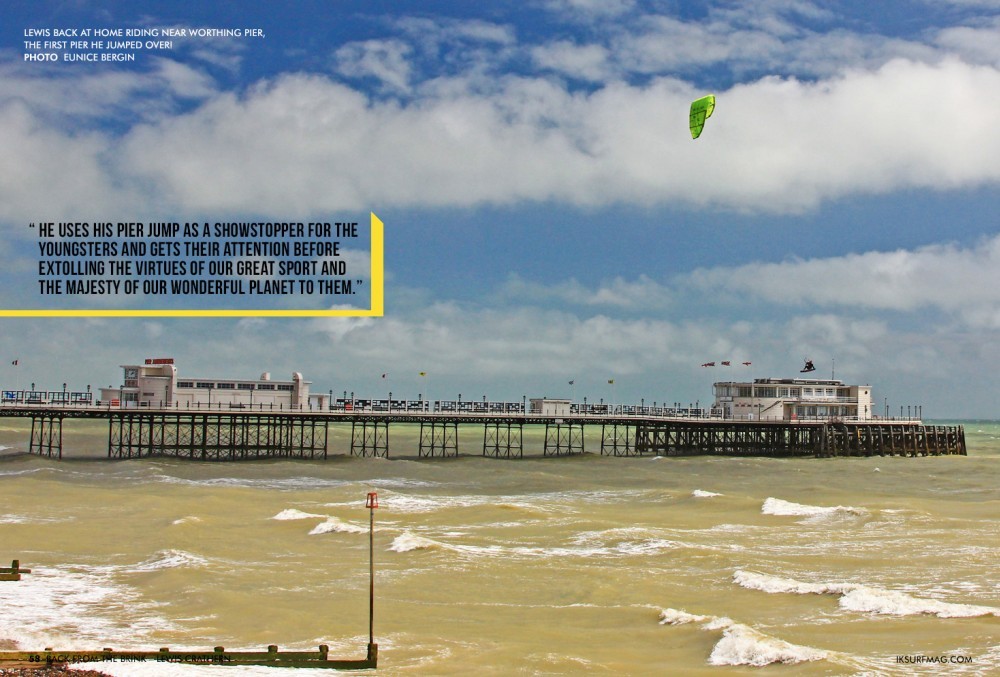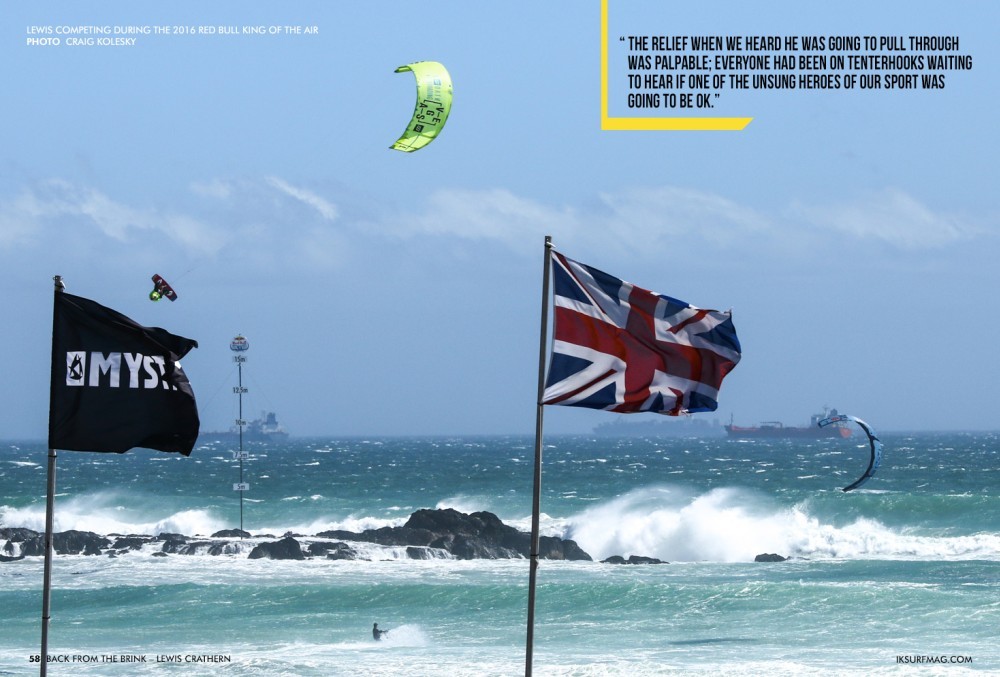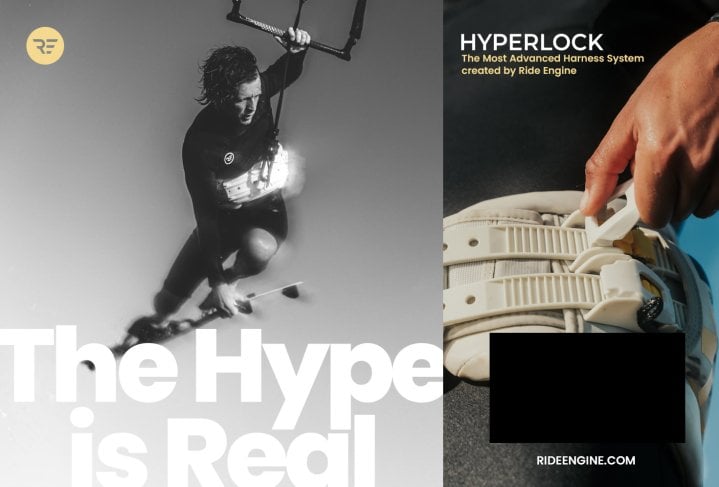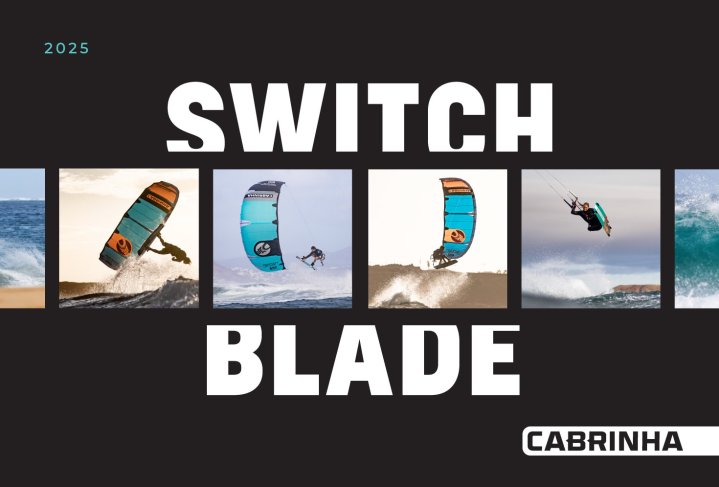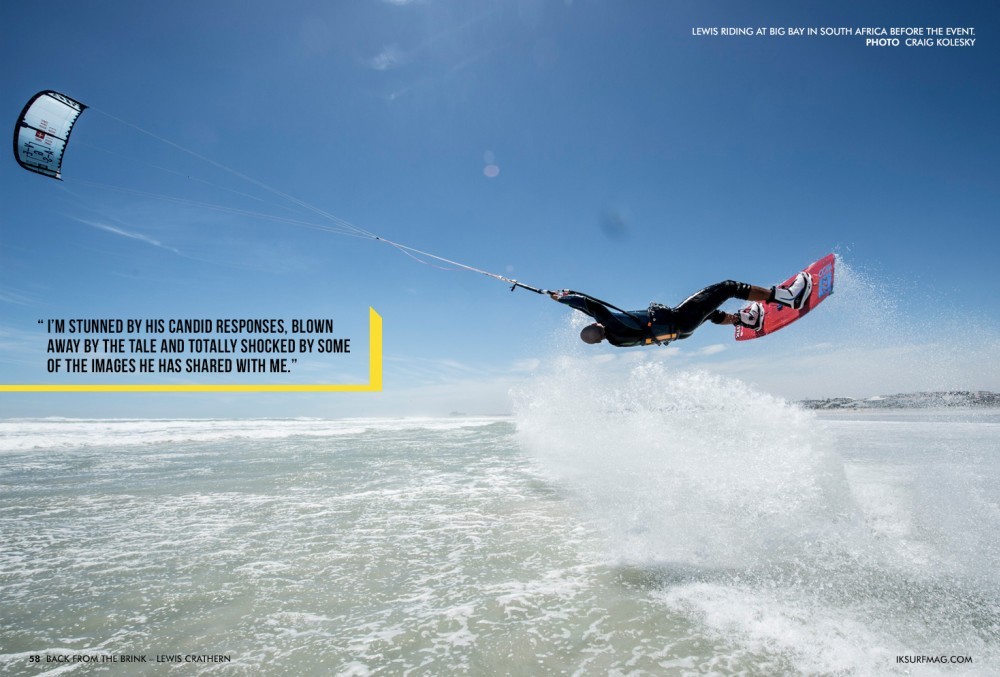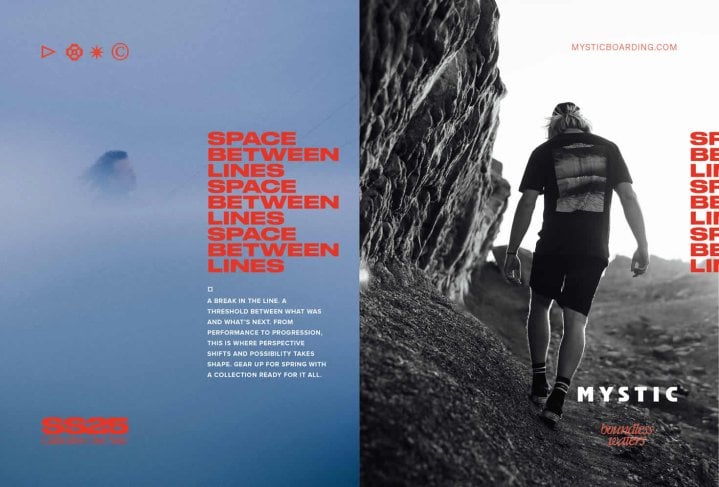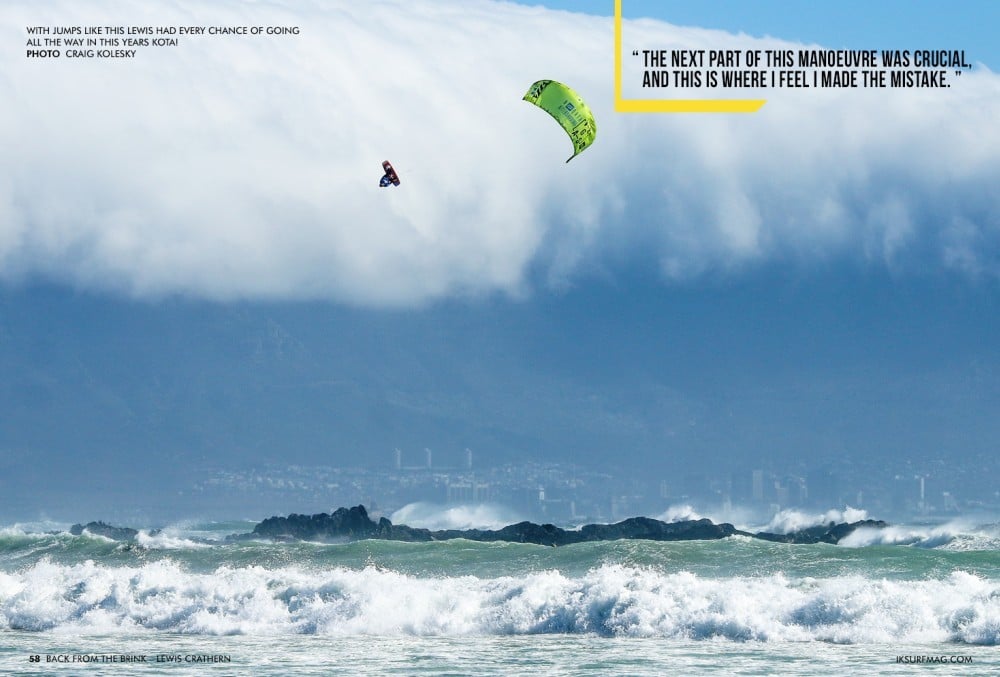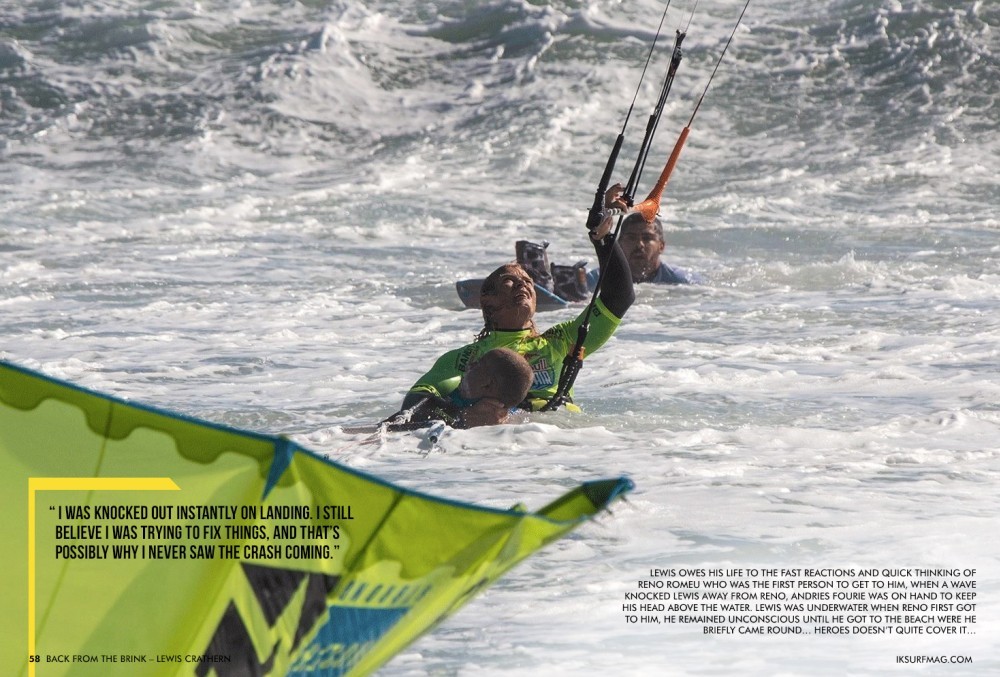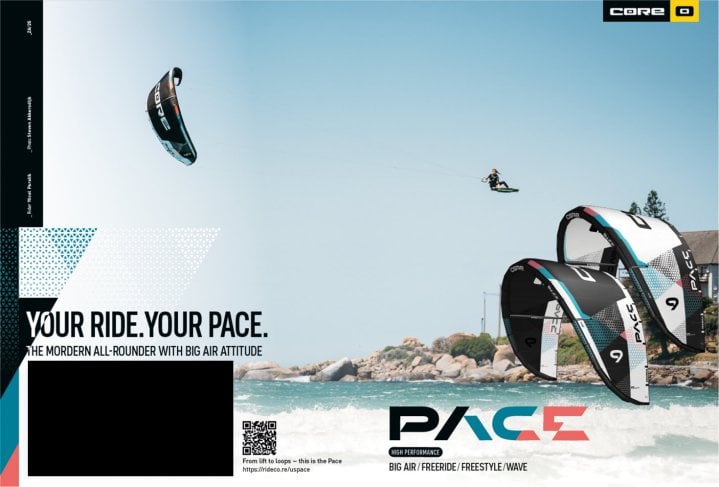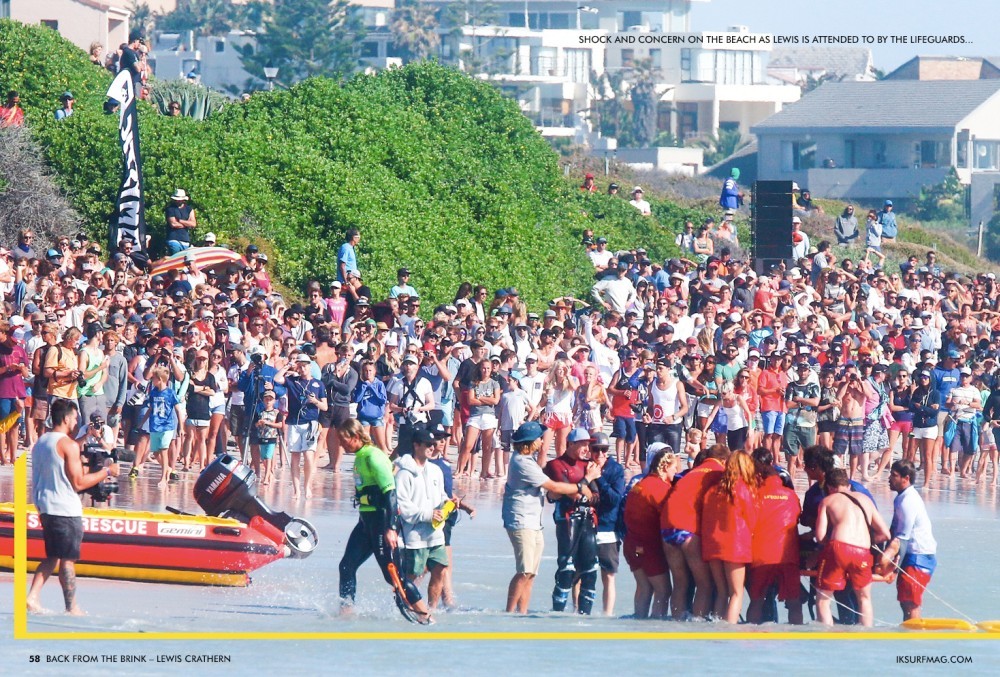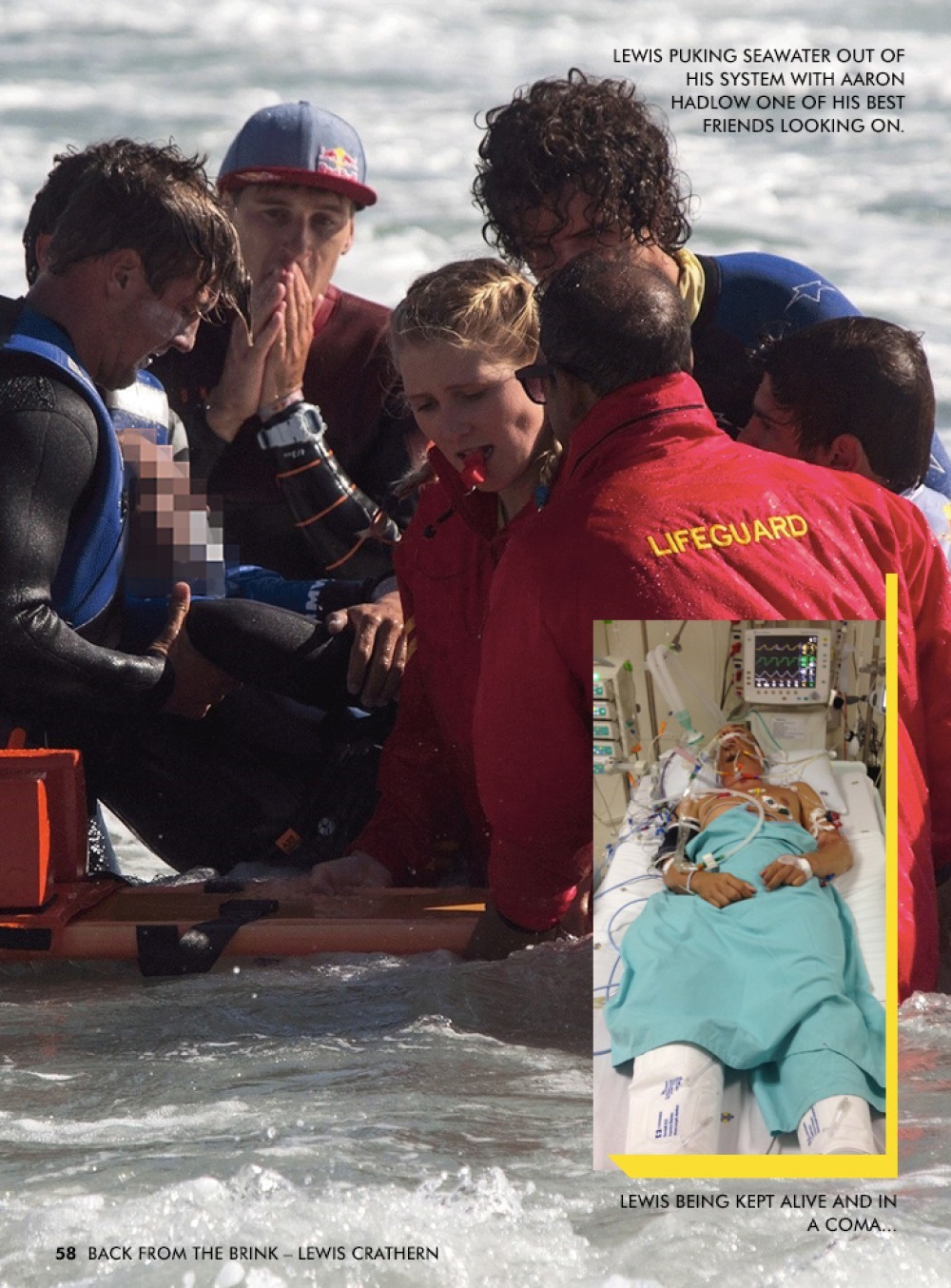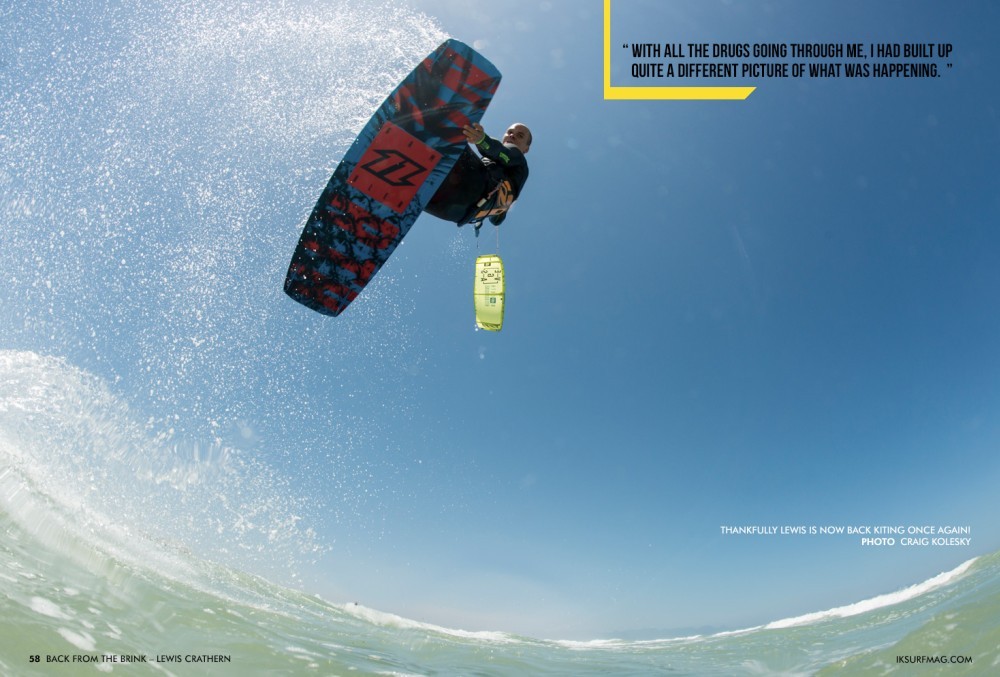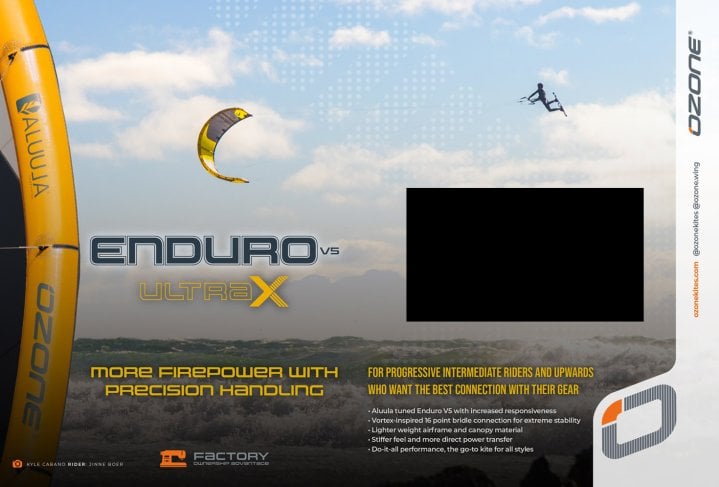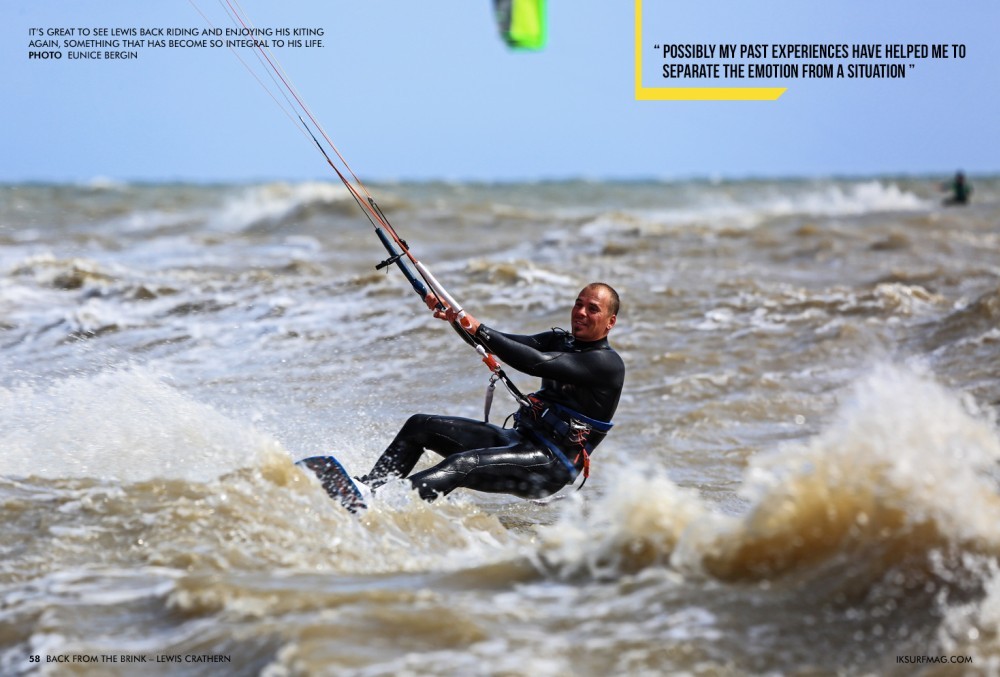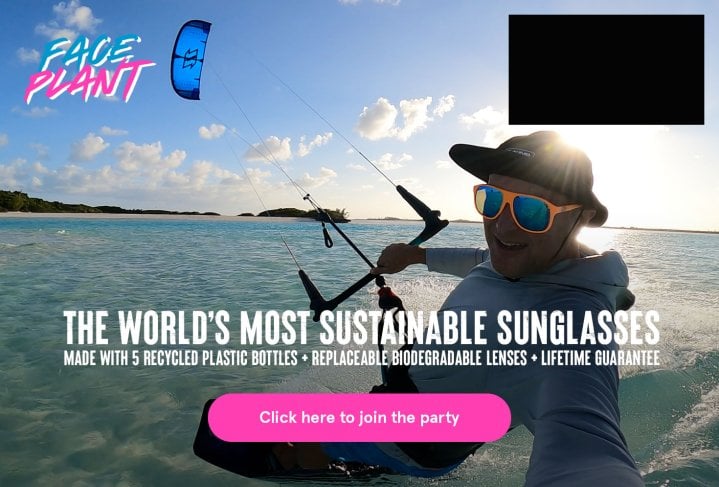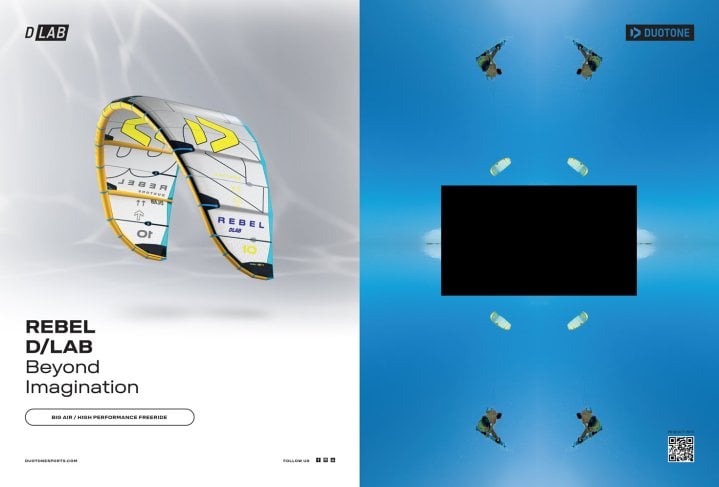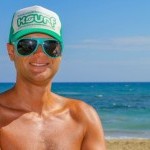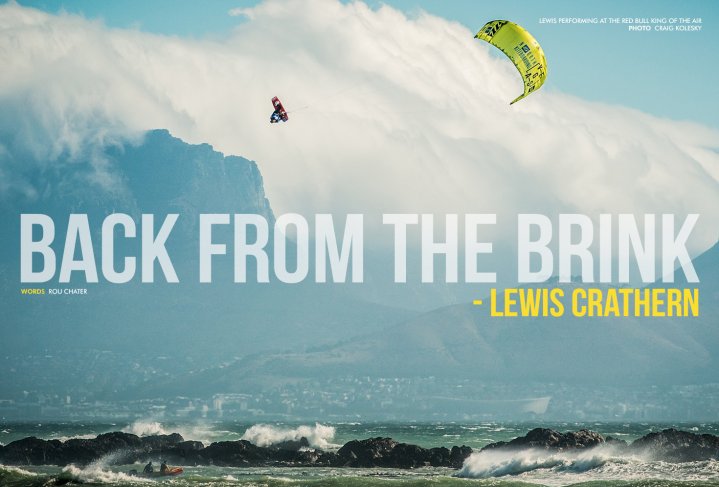
Back From The Brink - Lewis Crathern
Issue 58 / Tue 9th Aug, 2016
Possibly the most amazing story we have ever told, Lewis Crathern talks candidly about his near death experience, his road to recovery and getting back on a board.
Lewis Crathern had one of the worst crashes in the history of our sport in February this year at the Red Bull King Of The Air in Cape Town. He came as close to death as anyone would ever wish to get, but now he’s back on his board and almost back to full fitness. Rou Chater sat down with him to get arguably the most compelling story we have ever told!
I’ve known Lewis Crathern right from the start of his kiting career; I remember him turning up to a kite competition at our local beach with his buddy Jez. At the time Lewis couldn’t afford a board, but that didn’t matter, he just went out, and body dragged around, when Jez had finished riding Lewis had a go on his board. That was the first time I met him, and that memory stayed with me.
His passion for kiting has never faded, and after kitesurfing non-stop for two years, he went on to become a 4x British Champion winning the BKSA tour three times and the KBBT once. He’d come a long way from those early days, his talents on a kiteboard were impressive, however, he never really managed to break through to the world stage like some of the other big name riders.
Lewis is from a modest background and was never funded by huge sponsorship deals or trust funds. His answer machine message used to crack me up, “Hi, you haven’t got hold of Lewis, I’m not here right now, but don’t leave a message as I’ve got no credit to call you back”! Some kiters get to the top through unbeatable talent, others from having sound financial backing, Lewis, though, made it through sheer grit, determination and hard work.
He was always known for his huge airs, “hangtime” was a phrase that he and his buddy Jez arguably invented back in the day. Therefore, I wasn’t surprised when I heard he had jumped over Brighton Pier in 2010; it was an amazing feat that made him the most famous kitesurfer on the planet at that moment. Even to this day when I meet people and tell them, I kitesurf they will invariably mention Lewis and the pier jump. I usually, proudly, say he’s a friend of mine, and I still find it amazing that six years on his riding has reached out to so many people.
I interviewed Lewis for the magazine after that jump, and I found out a little more about what made this eager-eyed kid from Worthing tick. You can read that piece HERE. These days it would be fair to say Lewis has mellowed, but his passion for the sport still runs strong. In the UK he talks to thousands of kids every year about the benefits of kitesurfing, tied in with the importance of renewable energy and wind power.
He uses his pier jump as a showstopper for the youngsters and gets their attention before extolling the virtues of our great sport and the majesty of our wonderful planet to them. It’s a side of Lewis that a lot of people who don’t know him won’t know about, he’s modest to a fault and always seems more interested in what you’ve been up to rather than telling you all about his escapades.
The last time I saw him he was late for dinner, he just casually mentioned he had been teaching groups of teenagers back to back all day to fly power kites at a local school. Needless to say, he was excused…
These days Lewis is famous for something else, arguably an accolade many wouldn’t want, but something Lewis carries with his immutable modesty and good nature. This year at the Red Bull King of The Air I had to watch someone I consider a good friend have one of the worst crashes this sport has ever seen and then, effectively, drown on live TV.
Shocking doesn’t cover it, I wasn’t in South Africa and was watching and reporting on the Live Stream from the Caribbean for the website. I was stunned, scared and incredibly worried the while feeling utterly hopeless. I wasn’t alone of course, and the hundreds of people on the beach at Big Bay, including some of his closest friends as well as all the people watching the show from around the world, were left feeling the same fears.
Lewis spent what seemed like forever in a medically induced coma; I had guys on the ground giving me daily updates, and we relayed those to all the people at our kite spot asking after him. The relief when we heard he was going to pull through was palpable; everyone had been on tenterhooks waiting to hear if one of the unsung heroes of our sport was going to be OK.
Lewis seems to have an incalculable knack of capturing people's hearts, he reached out to so many people when he jumped over Brighton Pier, and in February it seemed like the entire kiting world, and even those outside were hanging on for a piece of news from Cape Town.
Thankfully, Lewis is back; he’s riding his board again, and it makes me incredibly proud to bring you this interview that he has given us. I’m stunned by his candid responses, blown away by the tale and totally shocked by some of the images he has shared with me. When I first read the story, I instantly knew he deserved the cover of the magazine, and I knew it needed to be something different, something special, to commemorate what a remarkable young man Lewis has grown up to be.
Interview
Let's go back to the King Of The Air in Cape Town, I was watching the live stream and thought you were riding incredibly well, I had you tipped for the podium! How did you feel the event was going before the crash?
The event was going amazingly; it’s the highlight of my year. To me, it’s like a celebration of big air kiteboarding in an extreme environment. It’s one of the few times at an event that a real crowd comes to watch.
I had only been riding my new North gear for a few weeks, but I felt comfortable on it. Finally, the conditions were 30 knots + which was exciting. Juggling the role of MC I’m completely immersed in the event which helps me relax and enjoy my riding. I found myself in the semi-finals, and I felt I could go all the way.
Can you talk us through what happened in the moments before the crash?
After watching it back, numerous times, I know exactly what happened. Simply put I made a mistake. 100% me, it was hard to accept at first it still is.
Now, in technical terms…
I committed to launching off a wave, which broke just before I took off. It pushed my board around behind me slightly so I was a little off balance on the way up. Still, I had a good body position and felt tension was fine so I committed to sending the kite into the kiteloop. The classic picture you see very much looks as if I’m in the ‘Boogy’ Loop (Front Roll Megaloop) position but in fact, I’m almost in a reverse raley position.
At this point things still felt good, I was looking directly at the kite, and I never lost aerial awareness, which is my biggest fear when performing these moves.
The next part of this manoeuvre was crucial, and this is where I feel I made the mistake. I was now ‘stuck’ backwards, and my concern became to get back round. I chose to try and throw in a late backroll, but due to the strange position I was in when I looped the kite, I had no momentum to throw my body around.
If you watch the video closely, you can see I go through this thought pattern:
Throw the late backroll - Realisation it’s not going to bring me round so try to go the other way - Realisation that’s not going to work either so try the original way again - Accept I’m stuck backwards - Realisation in all this faffing around I’ve accidentally over steered the kite so it’s not above my head anymore - And the last act of desperation which takes place about 5 meters from impact, redirect the kite back to 12 - But it was too late.
It doesn’t often happen that we come in backwards in kiting. I describe it like cats landing on their feet. There have been numerous times I’ve experienced being backwards on a kite and it just seems to work itself out, but it this case it didn’t.
We’re you knocked unconscious on landing, or was there a moment when you knew what had happened?
I was knocked out instantly on landing. I still believe I was trying to fix things, and that’s possibly why I never saw the crash coming.
In the aftermath of the wipeout a few key people came and helped out, Reno Romeu was first on the scene, do you have much recollection of that, and have you watched it back on YouTube?
I have no recollection of the aftermath, but one thing I know is that I owe my life to the quick reactions to Reno Romeu and Andries Fourie. What they did completely encapsulates our sport and how together we are; ready to help each other, not only with launching and landing but also with the rescue if needed.
As far as I am aware, Reno got to me first. He mentioned to me that he just saw lines coming out of the water, and I had ended up beneath the surface. He then got underneath me and pushed me up and out of the water. Waves came in, and we got separated, then, Andries managed to grab me and keep my head out of the water. One other element that was in my favour is that my kite was pulling me still towards the shore.
Can you tell us a little bit about what happened on the beach and at the hospital?
Again, I have nearly no memory of this, except slightly waking in the Lifeguard area and asking what had happened. I’ve learnt there was a concern I needed CPR but it was decided I was still breathing. It became a get him to the hospital as quick as possible scenario. I also remember very vaguely asking in the ambulance ‘what happened’, ‘what happened’? I had the same pain you get from breaking your ribs.
You had everyone pretty worried for a while there, your mum flew out to see you, and your girlfriend Courtney was there too, what was it like to wake up after being in a medically induced coma for the best part of a week?
That was the strangest experience ever actually. My mum and Dad had flown back out as they had only just come to visit three weeks beforehand. It was the first time they had visited me in Cape Town; they had the holiday of their lives! This second visit was rather different!
I woke up thinking the event had just happened so it was weird to be told it was all over a week ago. I was relieved to see faces I knew, and I was still heavily sedated on stuff and was quite scared. The doctor explained everything slowly, but I accepted what he said. I was in a lot of pain in my chest still.
The crash must have taken it out of you mentally and physically, how did you start to think about rehabilitation and getting back on your feet?
The challenge for me was mostly physical. The pain of breathing and worry of drowning again in the hospital if I didn’t get my breathing right became my only concern. I was still bringing up seawater for quite a while when I came round (they said this was normal). I made a deal with myself that I wouldn’t go to sleep. That’s how scared I was of losing my guard, being so close to getting through it I kept thinking how bad it would be if it didn’t work out. With all the drugs going through me, I had built up quite a different picture of what was happening. I could write a book on the strange dreams and visions I was having (I might, one day!).
I’ll give you a little insight….
I would stare at the TV up above me, which was switched off, and the standby light represented Guitar Hero lights (one of my favourite console games). There would be a healthy number of them on if I was concentrating on breathing correctly, but if I started getting it wrong, they would start going out. When you get down to one and a half lights, you start to panic. Noises and bleep sounds were going off behind me, my life support stuff, which I was wrongly tying into this surreal game. At night it was quite scary. Only the messages and cards on the wall that people had sent me got me through this; it gave me hope.
How good were the medical staff at the hospital, we heard you got a very high standard of care…
They were brilliant; it works quite differently out in South Africa with private care. All the medical staff were very skilled, and I made some great relationships.
You couldn’t fly home after you got out of the hospital, and had to stay until you were well enough to travel back to the UK...
It was the longest I’ve ever stayed in Cape Town. I was out there on December the 1st to spend Christmas with my girlfriend and her family. My flight was originally due to return at the end of February, but when I was released from the hospital, in the middle of February, I was told I could not fly for a month due to the lung injury.
Pressure from a plane is not good for that. It was not hard to accept; at that point, I just listened to what was best for me. I was quite a nice time actually, it took me back to the days of being a baby when you have no responsibilities in the world, there are people around doing everything for you every day as you can’t do anything yourself.
Mentally you must be incredibly strong to put that incident to the back of your mind and move forwards, you showed your mental strength and determination when you jumped over Brighton Pier, do you think your past experiences have helped you get over this event too?
I’ve had time to look back at the whole thing that happened at KOTA this year. I feel it was just the physical aspect that I had to endure. I look around at my family, friends and girlfriend and can see how much of a mental challenge they went through. That period of worry they endured must have been hard.
That wasn't the case with me. I didn't have to see myself while I was unconscious or in a coma. The images, which are quite graphic, of me at the beach do not set off any emotions within me. It is as if I am looking at somebody that I do not know in any way.
I like to think positively and always have. Possibly my past experiences have helped me to separate the emotion from a situation as I have done with the pier jumps.
What did you do to get back to the beach, what was the process to build your strength back up to getting back on the water?
I lost a lot of weight doing very little for so long. Also, my muscles were shot from lying down for two weeks solid in the hospital. Before I left Cape Town, I had a series of physio visits to help with this. The impact of the crash had quite an effect on my neck and back. If I’m honest I can still feel it a bit now, but it’s fading, they have told me it might take a year to get back to where I was, but I’m feeling quite good now but I continue to have regular physio appointments and visits to biokineticist, etc.
I think when we are regularly kiting we underestimate how much force is going through our bodies. With the break I had it helped me realise what great shape kiting itself keeps you in.
Did you have anyone to help you along the way, both physically and mentally?
Yes, my partner Courtney was great, and both my family and hers were incredibly supportive, also my sponsors too. Plus, all the people who contributed to my fundraiser and all the people who sent me cards and wished me well, that meant a lot to me and helped a lot.
Can you tell us a little bit about that first session under a kite again, what were the emotions like?
The first session was actually in Egypt end of March. It was at the first World Tour event of the year where I was commentating, and I was determined to make that trip. Looking back, it was probably too early to put myself through that, especially with the travel as well. The people there made me feel great when I took to the water, but it all felt normal after a couple of tacks. I noticed the lack of energy I had though, even cruising around on a 12m I felt weak. That was hard and probably the first time I accepted it would be a long while until I am fully fit again.
You're almost back to full fitness now, or at least it seems like you are; would you say you have made a full recovery or are there any lingering issues?
Well, I’m happy to say there are no lasting problems, and I’m slowly getting to a stage where I feel happy with how I look and how fit I am. I wouldn’t say everything is fully back to normal; I still need to work on flexibility and that sort of thing, but I feel fit.
Is your riding back up there, have you pulled any megaloops yet?
This year I’ve reignited that passion for boosting. I find myself taking the Rebel out 90% of the time, but I have had moments on the Vegas looping. At the Mystic distributor meeting, I found myself maxed on a 9m, and I sent some pretty big loops. I even took some massive crashes, and I enjoyed them. I bounced along and was happy.
I always feel better to have taken a big crash and been ok than not to have experienced a crash at all. Wakestyle has taken a bit of a back seat, but that’s also been down to this new era where we are all becoming so obsessed with how high we are jumping. I love being part of the WOO scene and seeing how high up the leader boards I can get on a regular basis.
The KOTA has taken a few scalps over the years, broken legs, crushed vertebrae, although I would say the incidents last year with yourself and Lasse Walker are arguably the events darkest. We’ll never stop people like you from pushing the limits of the sport, but can we work to make it safer? Built in impact vests in wetsuits, mandatory helmets, etc.? I know the pros don’t like the idea of helmets, but we had this in the past with mountain biking, wakeboarding and snowboarding, are we at a stage where we as an industry should be pushing this agenda?
I think what happened this year has definitely helped us re-evaluate safety within the sport, especially competitions like this. Whereas I feel an impact vest would make a difference and will be something I may well wear, I sit on the fence a bit with helmets. If there is sufficient evidence to prove it can help us, then of course, I think it’s something to consider.
Do you think there is a lack of understanding about the benefit of helmets in our sport, and do we need some kite specific technologies and studies to make helmets that can make riders safer?
Yes, I do. With my accident, I had information thrown at me both arguing I would not have been knocked out and also that I would have injured myself more if I had a helmet. That’s quite confusing! As I see it, helmets are nearly always used with the idea of heads coming into solid surfaces, but as they say, the water can be like concrete! The only way you can find this stuff out is by some more accurate research and development in our particular sport of kitesurfing.
You do a lot of work promoting kite sports, the wind and sustainable energy to schools in the UK, it’s a role you’ve done for years, will you be using this experience in your sessions moving forwards?
Yes, of course, when it’s right. I’ve decided that it’s not appropriate for anyone younger than high school kids. I don’t want to scare children! It can be quite challenging when the young ones ask, “have you ever hurt yourself”!
What’s next for you Lewis, will we see you at the King Of The Air in 2017?
Yes certainly, I wouldn’t miss the event for the world. Hopefully, in 2017 I can go one step further than being “knocked out in the semi’s!”
It’s great to see you back on the water Lewis, well done and good luck for the future!
Videos
By Rou Chater
Rou has been kiting since the sports inception and has been working as an editor and tester for magazines since 2004. He started IKSURFMAG with his brother in 2006 and has tested hundreds of different kites and travelled all over the world to kitesurf. He's a walking encyclopedia of all things kite and is just as passionate about the sport today as he was when he first started!




